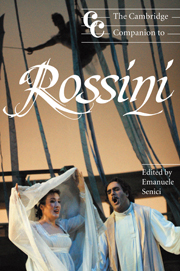Book contents
- Frontmatter
- 1 Introduction: Rossini's operatic operas
- Part I Biography and reception
- Part II Words and music
- 5 Librettos and librettists
- 6 Compositional methods
- 7 The dramaturgy of the operas
- 8 Melody and ornamentation
- 9 Off the stage
- Part III Representative operas
- Part IV Performance
- Notes
- List of works
- Bibliography
- Index
5 - Librettos and librettists
from Part II - Words and music
Published online by Cambridge University Press: 28 September 2011
- Frontmatter
- 1 Introduction: Rossini's operatic operas
- Part I Biography and reception
- Part II Words and music
- 5 Librettos and librettists
- 6 Compositional methods
- 7 The dramaturgy of the operas
- 8 Melody and ornamentation
- 9 Off the stage
- Part III Representative operas
- Part IV Performance
- Notes
- List of works
- Bibliography
- Index
Summary
Still more apprehensive of the disagreeable impression which might be gleaned from the libretto, Signora B***, in Venice, used to refuse to allow anybody at all to bring it into her box, even at the première. She used to get someone to prepare her a summary of the plot, some forty lines in all; and then, during the performance, she would be informed, in four or five words, of the theme of each aria, duet or ensemble, which had previously been numbered 1, 2, 3, 4 . . . etc., as each item was introduced in the performance; for instance, simply: Taddeo is jealous; Lindoro is passionately in love; Isabella is flirting with the Bey, etc. – this condensed summary being followed by the first line of the aria or duet which happened to be in question. I observed that everyone approved of this procedure, and thought it most suitable. In such a fashion should libretti be printed for the amateurs.
Such were the observations and proposals put forth by Stendhal in the chapter on L'italiana in Algeri in his Life of Rossini (1824). Happily, fewer and fewer people today consider the libretto to be little more than a pretext for an opera, a thin canvas threaded with commonplaces unworthy of serious consideration, or even an obstacle to enjoying the music undefiled. But it is still worth reiterating the case that the libretto of an opera simply cannot be ignored, and that it is the premise of all musical efforts. To appreciate fully the composer's work, it is absolutely necessary to give due consideration to the literary object on which it is based: its authors, events, stylistic levels, structures and conventions, the models from which it derives and its relationship to the contemporary theatre and other literary genres.
- Type
- Chapter
- Information
- The Cambridge Companion to Rossini , pp. 49 - 67Publisher: Cambridge University PressPrint publication year: 2004



